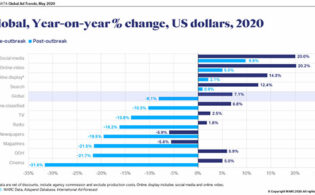Excluding political advertising, the $360 billion U.S. ad market is on track to rise by 5 percent this year and 4.3 percent in 2024, according to Madison and Wall, marking a return to “normalized growth” post the pandemic.
The media and technology newsletter penned by analyst Brian Wieser notes that including political advertising, the market will rise by 2 percent in 2023 and 8.1 percent in 2024. Wieser’s analysis is based on public filings from 80 individual companies and U.S. government data.
Wieser points to the expansion of the ad market during the pandemic. “Looking forward, it’s highly unlikely that such trends could continue. Instead, I expect a reversion back towards the lower end of mid-single digit levels, which should be considered normal, positive conditions for the industry.”
Wieser continues: “If anything, it could be considered a positive that the industry didn’t fall faster, or even decline over the past year and a half, especially as much of the industry seemed to try to talk itself into a downturn last year by fearing for a recession that never came.”
Madison and Wall projects U.S. ad revenue growth of 6 percent in Q3 and 8 percent in Q4, as compared with the year-ago rates of 3.5 percent and 0.1 percent, respectively. “I expect growth to normalize in a 4 to 5 percent range excluding the effects of political advertising. This presumes underlying economic growth in terms of GDP and personal consumption of around 1 to 2 percent in real terms and 4 to 5 percent in inflation-adjusted, or nominal terms. Political advertising, growing ever-larger, should account for 3 to 4 percent swings in growth each year going forward, and impact virtually every type of media with increasing intensity going forward.”
Wieser expects digital advertising—across search, social media, commerce, retail and platforms like YouTube—to take a 64 percent share of the U.S. ad pie. National television advertising, meanwhile, “is experiencing what might feel like an existential crisis at the moment,” amid continued cord-cutting and now the two strikes in Hollywood. The dispute between Charter and Disney—and subsequent questions about the entire pay-TV ecosystem—has made the situation worse.
“While it’s possible that most network owners and most carriers will continue to come to terms for carriage agreements as they have for many decades, and that cord-cutting then continues at ‘only’ a high-single-digit level, it’s also plausible that deals won’t be reached, in which case those consumers who want access to the channel packages they have today will have to subscribe to over-the-top virtual MVPDs such as Fubo, Alphabet’s YouTube TV, DISH’s Sling or—ironically—Disney’s Hulu + Live, who may be more tolerant of the lower profit margins that these platforms are built to manage around. Not every consumer will make such a shift, instead prioritizing streaming services for their television consumption. The consequences of those changes could be meaningful for advertising, as shifts to streaming make it almost certain to me that the tonnage of advertising those consumers are exposed to will go down significantly as a result.”
There is some upside for U.S. TV networks, Wieser adds, “if they redefine what they have historically sold. To the extent that they can capitalize on what are still sizable relationships with marketers to offer a wider array of media products—for example, by creating common identifiers that allow for integrated sales of traditional TV, streaming video and other digital inventory—I think there are opportunities for growth ahead.”






